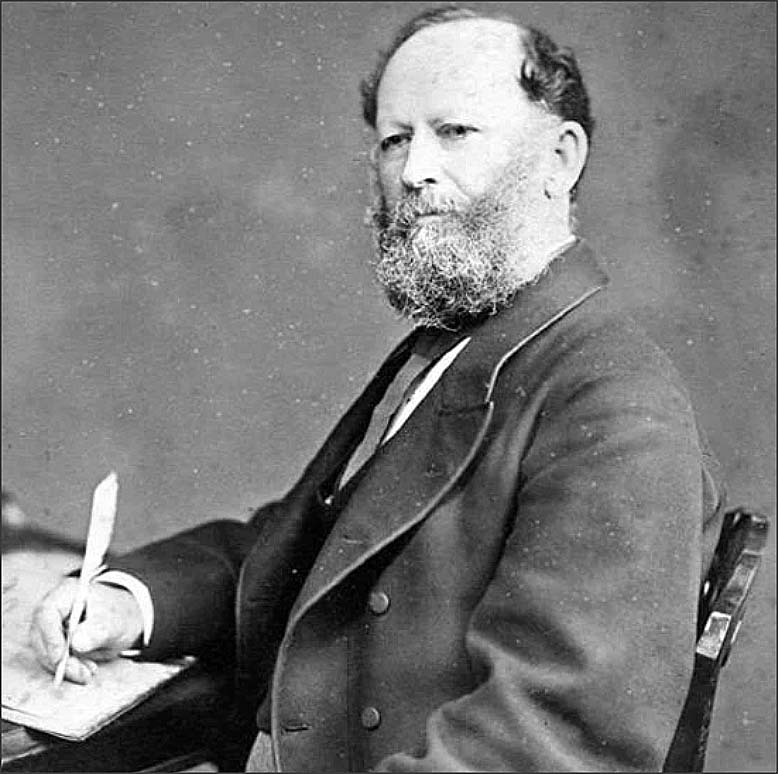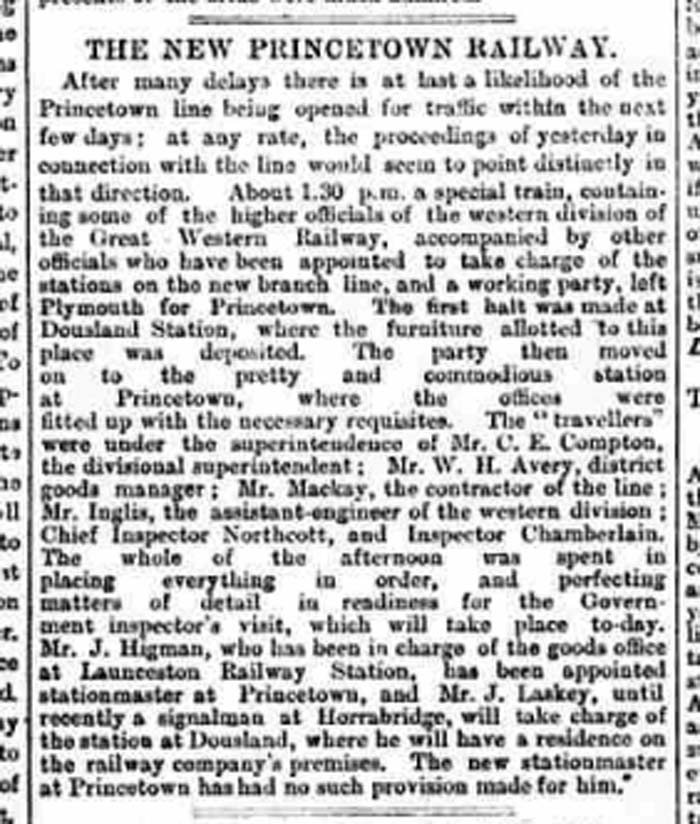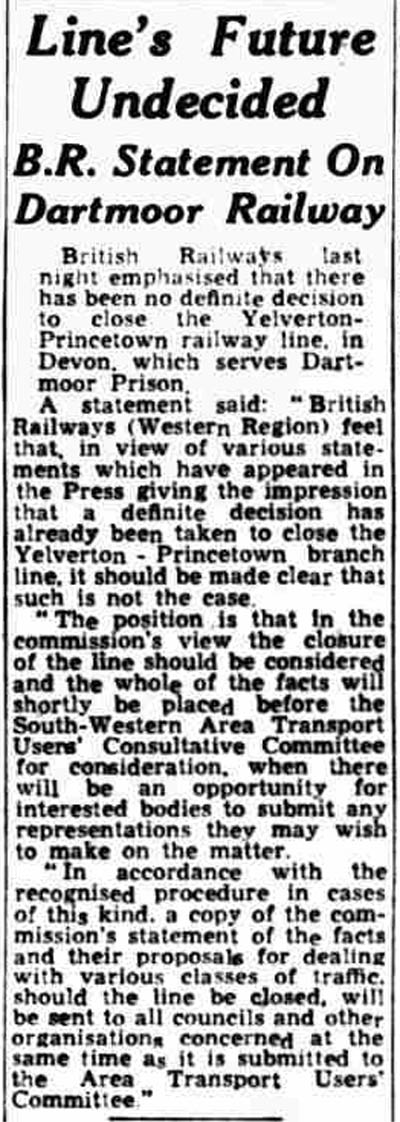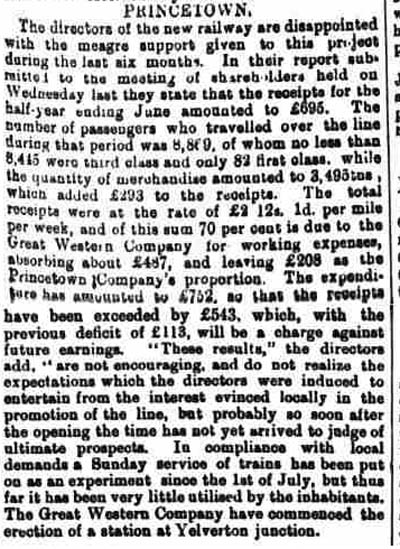On 7th July 1883, Colonel Yolland of the Board of Trade conducted an inspection of the line but discovered several unsatisfactory issues. Consequently, he declined to grant the approval for opening. Following some alterations, he made a second visit, and the line commenced operations on 11th August 1883, without any formal ceremony.

Upon its opening, passenger trains operated from Horrabridge, passing through Dousland and reaching Princetown. At Yelverton, there was only a goods siding available. Colonel Yolland from the Board of Trade had stipulated that either a junction station should be established at Yelverton or Horrabridge station should be expanded to accommodate interchange traffic. Initially, Horrabridge served as the junction station. However, the Great Western Railway (GWR) inaugurated a station at Yelverton on 1st May 1885. From that point onwards, branch passenger trains ran to and from Yelverton.
Western Morning News – Thursday 09 August 1883:
THE NEW PRINCETOWN RAILWAY. After many delays there is last likelihood of the Princetown line being opened for traffic within the next few days; at any rate, the proceedings of yesterday connection with the line would seem point distinctly in that direction.
About 1.30 p.m. special train, containing some of the higher officials of the western division of the Great Western Railway, accompanied other officials who have been appointed take charge of the stations on the new branch line, and a working party, left Plymouth for Princetown. The first halt was made at Dousland Station, where the furniture allotted this place was deposited. The party then moved on to the pretty and commodious station Princetown, where the offices were fitted up with the necessary requisites.
The “travellers” were under the superintendence of Mr. C. E. Compton, the divisional superintendent; Mr. W.H. Avery, district goods manager; Mr. Mackay, the contractor the line; Mr. Inglis, the assistant-engineer the western division ; Chief Inspector Northcott, and Inspector Chamberlain. The whole of the afternoon was spent in placing everything in order, and perfecting matters of detail in readiness for the Government inspector’s visit, which will take place to-day.
Mr. J Higman, who has been in charge of the goods office at Launceston Railway Station, has been appointed at Prince town, and Mr. J. Laskey, until recently a signalman Horrabridge, will lake charge of the station at Dousland, where he will have a residence the railway company’s premises.. The new stationmaster Princetown has had no such provision made for him.

The Atmosphere of Opening Day
The Princetown Railway, a symbol of progress and comfort, commenced its operations amidst a spirited celebration. The people of Princetown had prepared for this day with decorations and festivities, but due to some uncertainty, the actual opening date was not known until a welcome announcement on Saturday morning that the line had been certified by the Board of Trade.
The first train from Horrabridge, scheduled for 9:05 a.m., was delayed as certain rolling stock needed for the journey was not yet in place. However, the 12:08 p.m. train from Horrabridge became the inaugural ride, carrying a considerable number of passengers, including officials from the railway company.
The route to Princetown provided passengers with breath-taking views of the surrounding landscapes. Some of the scenic highlights included the picturesque the beauty of Walkhampton Down, and the impressive boulders on the hillside.
The Princetown Railway stretches for ten and a half miles from its junction at Yelverton. Much like the highway connecting Tavistock and Princetown, the railway runs uphill for most of its journey. It begins by passing along a twenty-foot-high embankment that curves away from Roborough Down, offering a glimpse of the charming village and parish church of Meavy on one side and the picturesque moorland view on the other.
Further along the route, the railway enters a deep cutting, where the dark walls are left behind, replaced by a scenic view. Near this location, unfortunately, the construction of the line witnessed a tragic incident resulting in the burial of two navvies under falling debris.
Continuing its ascent, the railway reaches Dousland station, situated a mile and a half from Yelverton. After a brief stop here, the train continues uphill, skirting Yanadon Down and following a winding path until it reaches a point above which the Devonport leat flows while the Plymouth leat flows below. This spot offers a splendid view of the Sheepstor valley.
The railway then crosses the Sheeptor and Lawrey roads before arriving at Peek Hill, where it passes under a granite arch. As it traverses Walkhampton Common, a beautiful landscape unfolds towards the west, featuring the river Tamar nestled among the Cornish hills. From this vantage point, one can see Walkhampton church and Horrabridge below.
To accommodate the needs of the nearby community, a siding with signals and other facilities has been established on Walkhampton Down, serving as a valuable resource for the transportation of heavy goods for local farmers.
Continuing its journey, the railway passes notable landmarks such as Ingletor, King Tor, Foggen Tor, and Swell Tor. Remarkably, after a distance of about three miles around the hill, the train finds itself only a quarter of a mile below its previous location, having ascended 150 feet in elevation.
About half a mile from the crossing of the Lawrey Road, the railway encounters its only decline on the way to Princetown, featuring a gradient of 1 in 55. However, after this point, the line steadily ascends until the train eventually reaches Princetown, standing 850 feet above Yelverton and an impressive 1,550 feet above sea level
Princetown had adorned itself with triumphal arches, flags, and bunting to mark the special occasion. The community had organized a committee to oversee the festivities, with the governor of the prisons, Capt. O. W. Every, as the chairman. The celebrations included a free tea for children and a public tea for adults at a nominal charge to cover expenses.
The station at Princetown itself was a well-designed and attractive structure, boasting a spacious waiting room, ladies’ waiting room, booking office, and stationmaster’s apartment. The platform was designed to accommodate increased traffic, and there were facilities for goods handling and storage.
Chief-Inspector Northoote and Inspector Chamberlain diligently observed the proceedings throughout the day, ensuring the smooth operation of the railway. The celebrations extended to Dousland Barn, where a sports event, tea, and dance were held.
The sports events were well-received, with participants enthusiastically competing in various races. The community contributed generously to the event, with around £20 raised for prizes and the children’s tea.
In summary, the opening of the Princetown Railway was a grand occasion, bringing joy and excitement to the town and its inhabitants. The successful launch of the railway promises to facilitate transportation and bring new opportunities for the region.




